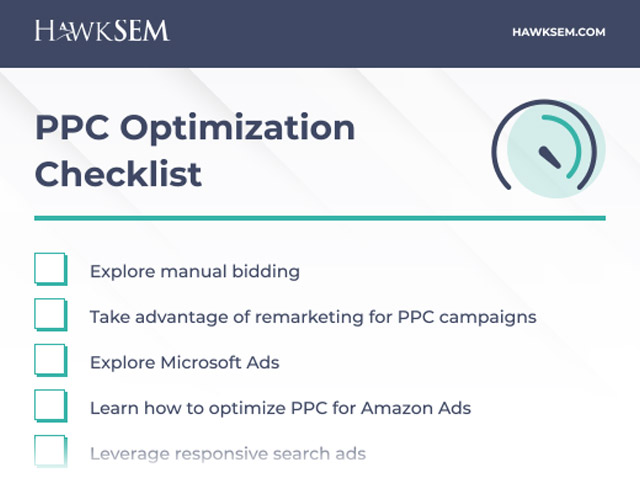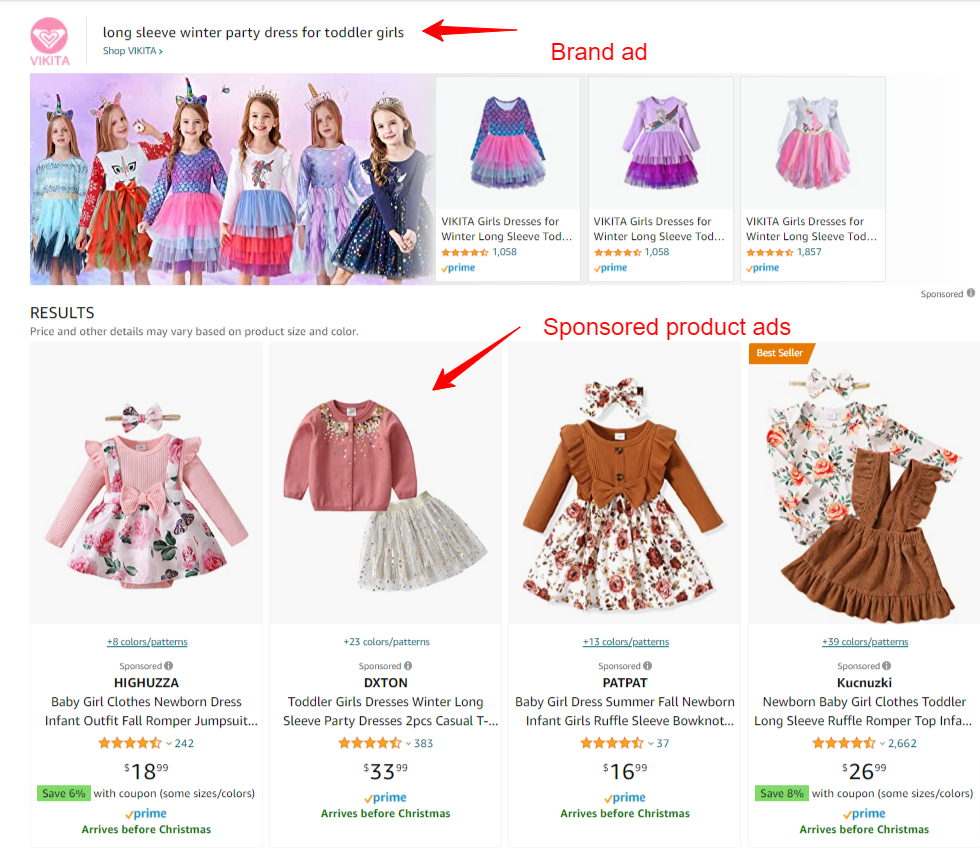PPC marketing is a proven way to get fast results from digital advertising. But it requires refining, updating, and optimizing for best results. Enter: PPC optimization.
Here, you’ll find:
- Why Google Ads isn’t the only game in town
- Reasons manual bidding is worth your attention
- Expert tips on pay-per-click (PPC) optimization in 2023
- What Core Web Vitals are and why they matter for PPC
We like to say that digital marketing is part art, part science.
Sure, there are guidelines, processes, and steps — but without a heavy dose of creativity, your program isn’t likely to rise to the top.
Well-versed paid search marketers know this.
They also know that experimentation, analysis, and optimization are key components to creating a PPC strategy that isn’t just successful, but lasting too.
Behaviors, competitors, and algorithms change fast. To stay on top of your game, you have to catch on before someone else does. Let these PPC optimization strategies guide your paid search efforts for 2023 and beyond.
1. Explore manual bidding
No matter how stellar your PPC advertising efforts are, your ads won’t achieve proper results without the right bidding strategy. The tactic you choose for your keyword bids depends on your campaign goals.
If you want to achieve the highest number of clicks according to your set ad spend budget, you can use the traditional automatic cost-per-click (CPC) bidding system.
However, allowing Google to do the job for you comes with downsides. One is the limitation to adjust your campaign if it’s not performing properly.
Manual bidding can fix this problem, since it has a more hands-on and customized bidding approach that:
- Increases ad visibility
- Lowers your cost per action (CPA)
- Allows you to prioritize keywords that convert better
However, switching from automatic to manual bidding is an advanced strategy
Often, it requires paying close attention to tactics such as:
- Focusing on one campaign at a time, since the process can be time-consuming
- Lowering bids for keywords that receive solid impressions but don’t generate sales or leads
- Increasing bids for high-performing keywords that convert to boost the position of those ads and generate more conversions
- Choosing the default bid, which is close to the average CPC in your automatic campaigns
Manual bidding is great when you need more control over bids. But this strategy also means more time goes into ensuring you bid the right amount at the right time.
“Manual bidding is okay in the beginning as your account is accruing data,” says Steve Dang VP of Growth and Strategy at HawkSEM. “But it’s highly recommended that you transition campaigns towards more robust bidding strategies.”
For example, you can take advantage of intelligent bidding strategies using automated rules to:
- Pause poorly performing keywords
- Raise bids to top of page or first page
- Raise or lower bids during certain times of day
- Maximize conversions based on what worked in the past
- Target Cost per Action (CPA) to increase conversions
Pro tip: When you leverage manual bidding, it’s a good idea to run the manual campaign for a couple of weeks to see if it achieves the goal of lowering CPC and generating sales.

While recent data and privacy updates have posed some additional hurdles to remarketing, there are still ways to create ad groups that specifically target these prospects. (Image: Unsplash)
2. Take advantage of remarketing for PPC campaigns
Almost no one converts (aka completes a purchase) on their first website visit. Does that mean you’re wasting your money on PPC ads?
Of course not.
Just boost their success by pairing them with remarketing campaigns as part of your PPC optimization plan.
This process uses ads to re-engage potential customers who clicked your ads or visited your site. Placing your ad in front of them serves as a tasteful reminder of the action they should take on your website.
While recent data and privacy updates have posed additional hurdles to remarketing, there are still ways to create ad groups that specifically target these prospects.
According to Steve, most people default to 30 days for a remarketing list, but should instead adjust this based on business needs. For instance, if you have a longer sales cycle, you can build remarketing lists that tag users who visited your site over the past 60 to 90 days.
“Video retargeting is a powerful but under-used vehicle. This combines retargeting and YouTube/video and allows advertisers to only go after users who have interacted with the business in the past on Google’s video platform.”
3. Explore Microsoft Ads
Google Ads is the clear leader in the PPC marketing realm. But that doesn’t mean other avenues aren’t worth exploring.
For some companies, a PPC optimization strategy might include using Microsoft Advertising to increase their paid search ROI.
Depending on your industry and the location you’re targeting, there’s often less competition on non-Google search engines and platforms, which means lower CPCs.
But while it’s easy to import a campaign over from Google Ads and let it run its course, you may be missing highly useful tools these platforms have to offer.
For example, Microsoft advertising has:
- Action extensions – add call-to-action (CTA) buttons near your ad that link to the landing page of your choice
- Review extensions – feature reviews from third-party sites below your ad
- LinkedIn profile targeting – target people by company, job function, and the industry in which they work
- Competition insight – see how your ads compare to your competition
4. Pay attention to Amazon Ads
Amazon Advertising presents another PPC optimization opportunity for ecommerce brands.
While the audience covered by the likes of Google, Microsoft, and Facebook Ads is huge, those who see your ad on those platforms aren’t necessarily in the decision stage of the buyer’s journey.
Amazon audiences, on the other hand, are generally closer to the bottom of the sales funnel. People who visit this shopping giant are likely ready to buy, which increases your chances of conversion.
These are the types of sponsored Amazon ads available:
-
- Brand ads: Display as banner ads in search results
- Product ads: Show within the search results for selected keywords as promoted relevant results
- Brand videos: That auto-play while also showing an image, description, and link to the product
- Lockscreen ads: For ebooks
As far as targeting goes on Amazon, you can opt for automatic or manual targeting. The former includes close match, loose match, substitutes, or complements, and it relies on the ‘zon’s algorithm to determine the related keywords to target.
As time goes on, it’ll compile data from clicks and purchases to (hopefully) increase your conversion rate.
For manual targeting, you decide which keywords to bid on. Your ads should surface when a shopper searches using those keywords (as long as the competition isn’t too fierce).
When it comes to optimizing Amazon PPC ads, you have a few options
As Seller App explains, those options include:
- Setting up a structured ad campaign, ideally with campaigns for each primary product category
- Being as precise and descriptive as possible in your ad copy
- Leveraging Amazon’s Search Term Report to see which keywords to include in your title or headline
- Using high-resolution, high-quality imagery
- A/B testing and monitoring metrics to see what resonates with your audience so you can optimize and modify accordingly
For Amazon PPC optimization, what works for one brand may not work for another. This marketplace is vast — depending on your industry, you may have to employ some out-of-the-box strategizing to get your campaign to stand out.
Don’t be afraid to mix up your imagery (especially since Amazon lets you upload multiple images per product) and play off of relevant trends in your copy, then monitor campaign performance to see if you’ve hit the right note.
Pro tip: You don’t need to sell your products on Amazon to take advantage of this advertising option.
5. Leverage responsive search ads
After first appearing in 2019, Responsive Search Ads (RSAs) quickly grew in popularity. That’s partly because these ads allow you to create 15 headlines and four descriptions for your ad.
Google then tests various combinations of these elements and selects those that perform best depending on factors like:
- Keywords searched
- Devices used
- Browsing behavior
Lastly, responsive ads save time and money on A/B testing while allowing you to reach your target audience faster.
Pro tip: Google sunsetted expanded text ads in June 2022, meaning RSAs are now Google’s preferred ad type.

Core Web Vitals show how good of user experience you should aim to offer your visitors. (Image: Unsplash)
6. Optimize your website
Even with PPC optimization, your marketing campaign results can still fall below expectations if you don’t optimize your website.
Now, Google factors in Core Web Vitals when determining the rank of your pages. These vitals include:
- Loading performance: The page should load in under 2.5 seconds.
- Visual stability: Page elements shouldn’t move when the user is reading the text (it usually happens when a piece of media loads), forcing the visitor to search for their lost place.
- Interactivity: The time between the visitor taking action (like clicking a button or tab) and the website responding should be under 100 milliseconds.
Core Web Vitals show how good of a user experience you should offer visitors. Improving them won’t just increase search engine optimization efforts, but it’ll also help your PPC ad clickers convert.
For on-page content: Follow the E-A-T strategy
In other words: Expertise, Authoritative, Trustworthy. Enrich your site with high-value content that is actionable and relevant to your target audience.
This is critical now that Google’s recent Helpful Content update, and its disdain for AI written content. To prove to Google your content is valuable, then it must include things like:
- Comprehensive and detailed body content
- Examples with screenshots
- Quotes for internal or external SMEs
- External sources and citations
- Author or publisher biography (preferable an industry expert)
- Detailed answers to reader questions and walk-throughs
Let’s not forget about optimizing landing pages for your target audience. Each landing page should have:
- Headline that’s compelling and relevant
- Content that talks directly to the audience
- Focal point on the benefits and features
- Call-to-action should be prominent and in several areas of the page (e.g., above the fold, in the beginning, middle, and end)
- A robust description of the product/service
- Testimonials (text or video) and social proof (logos, brand names)
Here’s an example of a landing page by Help Scout that does all of this well:
7. Revisit your keywords
When’s the last time you took a long, hard look at your keywords?
“Regularly comb through the search terms report to key in on new ways that people are searching, it is a gold mine for both positive and negative keyword ideas,” advises Steve.
Keyword research is vital to expanding your current lists by updating them with negative keywords and removing underperforming search terms.
Here are a few tips for identifying keywords to remove from your campaigns:
- Look for keywords with low click-through rates (CTRs)
- Identify keywords with high costs, yet little returns
- Examine search query reports for additional insights
- Retire keywords that are overly competitive or too expensive in comparison to their conversion rates
Even actions as minor as adding an adverb or removing a term with a low search volume can help.
“You’ll know when to pause a keyword after running it for a few months and seeing little traction. Look to the data to tell the story on keywords,” says Steve.
Keyword research is also an opportunity to gauge your competition
“Keep a pulse on new entrants or competitors in the space if you have competitor campaigns, so you’re always targeting up-to-date competitor sets,” says Steve.
Seeing which terms your competition is ranking for could bring you closer to more clicks and higher ROI.
Pro tip: Consult your user search term reports in Google Analytics (GA) to find new keywords to add that aren’t already in your account, then use Google Keyword Planner for additional research.
8. Check in on your conversion tracking
Conversions help marketers determine what works in our campaigns, and what doesn’t. So set up conversion tracking properly to make data-informed decisions based on accurate numbers.
We highly recommend using GA4 (or at least getting prepared to use it) and a tool like Google Tag Manager (GTM) for conversion tracking.
Why? Let’s say you want to drive more form completions.
You can configure your tags in GTM, build your goals in Google Analytics, and import those GA goals to Google Ads. If you have the same goal for multiple channels (e.g., paid social media and paid search or SEO and paid search) it streamlines the conversion setup.
You can also configure Google Ads conversion tags directly in GTM (this bypasses GA, which means you only record Google Ads conversions).
As a bonus, once you link your GA and Google Ads accounts — which you need to do before importing goals — you can create remarketing audiences in GA and import those into your Google Ads.
If all this sounds like a bit too much to add to your plate, consider chatting with us — we’ve created our own unique marketing technology built to drive actionable insights, full-funnel attribution, and high-quality conversions that continuously improve your bottom line. Learn more about ConversionIQ here.
Pro Tip: Track the right actions, but not too many because this may confuse Google’s algorithms. Instead, go for more robust attribution models like data-driven instead of first or last-click-based attributions.
9. Add Performance Max campaigns into the mix
Performance Max, or PMax, is a new Google ads campaign type designed to enhance your strategy using automation and machine learning (ML).
It helps advertisers generate leads, increase online sales, and even drive foot traffic to stores via the product feed on Google Merchant Center.
“Prior to PMax, smart campaigns reigned supreme over other campaigns and offered zero visibility into performance or findings,” says Melissa Torre, Senior Search Engine Marketing Manager at HawkSEM. “I believe that with PMax, Google has finally answered millions of account managers’ pleas.”
With PMax campaigns, you can reach audiences across various platforms, including:
- Search
- Display
- Discover Feed
- Maps
- Shopping Ad Inventory
- YouTube
- Gmail
PMax campaigns also use automated bidding strategies to optimize conversions and ROI. Its algorithm uses customer audience signals to identify new target audiences.
Who should use PMax?
Companies with multiple objectives (e.g., targeting clicks and conversions) will find PMax campaigns useful, since it can automatically adjust bids to target clicks and conversions.
This is possible using machine learning, which analyzes user data to adjust bids and maximize the odds of achieving goals.
PMax campaigns also reduce manual work and optimize campaigns faster
“PMax is powerful when set up appropriately,” says Melissa. “We have higher visibility into the search terms and more control over what is being served. It augments current campaigns, not take them over. This wasn’t possible with smart campaigns.”
But Melissa wasn’t always on board with Performance Max campaigns.
“Like many other managers, I was hesitant to try PMax campaigns — given my history with other smart campaigns. But I had a new client that only ran smart campaigns in the past and was having trouble getting traction on their shopping campaigns. So as a hail Mary, I gave PMax a shot.”
She notes it takes time to see any results from PMax because, unlike other smart campaigns, it’s very conservative when it’s first learning.
The results
As for the results of her first campaign using PMax?
They were able to gain traction and blow their year-over-year (YoY) shopping performance out of the water. When analyzing just Shopping and PMax campaign YoY data, it showed the account spent 60% less on shopping campaigns and still achieved a 165% higher return on ad spend (ROAS).
Plus, it didn’t detract from other campaign performance — the overall account beat its highest-ever revenue (in Dec 2020) by 37% (in Nov 2022).
Looking to use PMax? Here are a few best practices to consider:
- Add exact match keywords to branded ads (even though PMax can pull from branded campaigns), then if that fails, you can negate terms impeding on other campaigns’ performance
- Split campaigns by products/services type so you can create highly-targeted landing pages, use lower funnel search terms, and use relevant ad copy and images for each ad group to boost conversions
- Prioritize new customer acquisition rather than remarketing or branded target (works like prospecting campaigns)
- Upload specific customer data and split by product/service so Google can target similar audiences
Pro Tip: Use PMax campaigns for purchase targeting (lead generation doesn’t seem to perform well yet)
The takeaway
PPC optimization is an ongoing process.
Add that to the multiple new options and updates happening every year, and it’s nearly impossible to thrive without analyzing regularly so you can keep enhancing your strategies.
At the end of the day, the best PPC ads are clear, consistent, targeted to the right audience, and follow through on what they offer. Use the above tips to guide you as you work to maximize PPC marketing efforts through this year and beyond.

Download The Checklist Now
This article has been updated and was originally published in July 2020.

